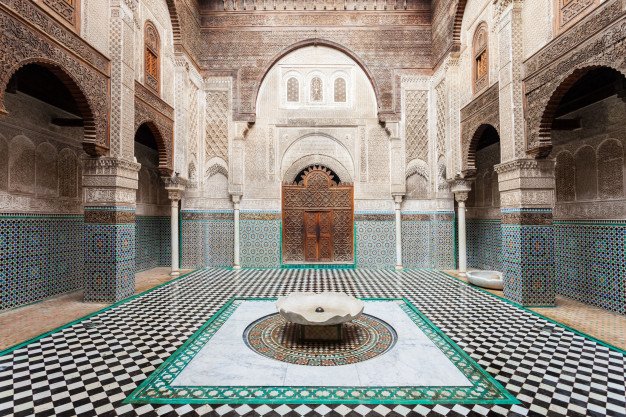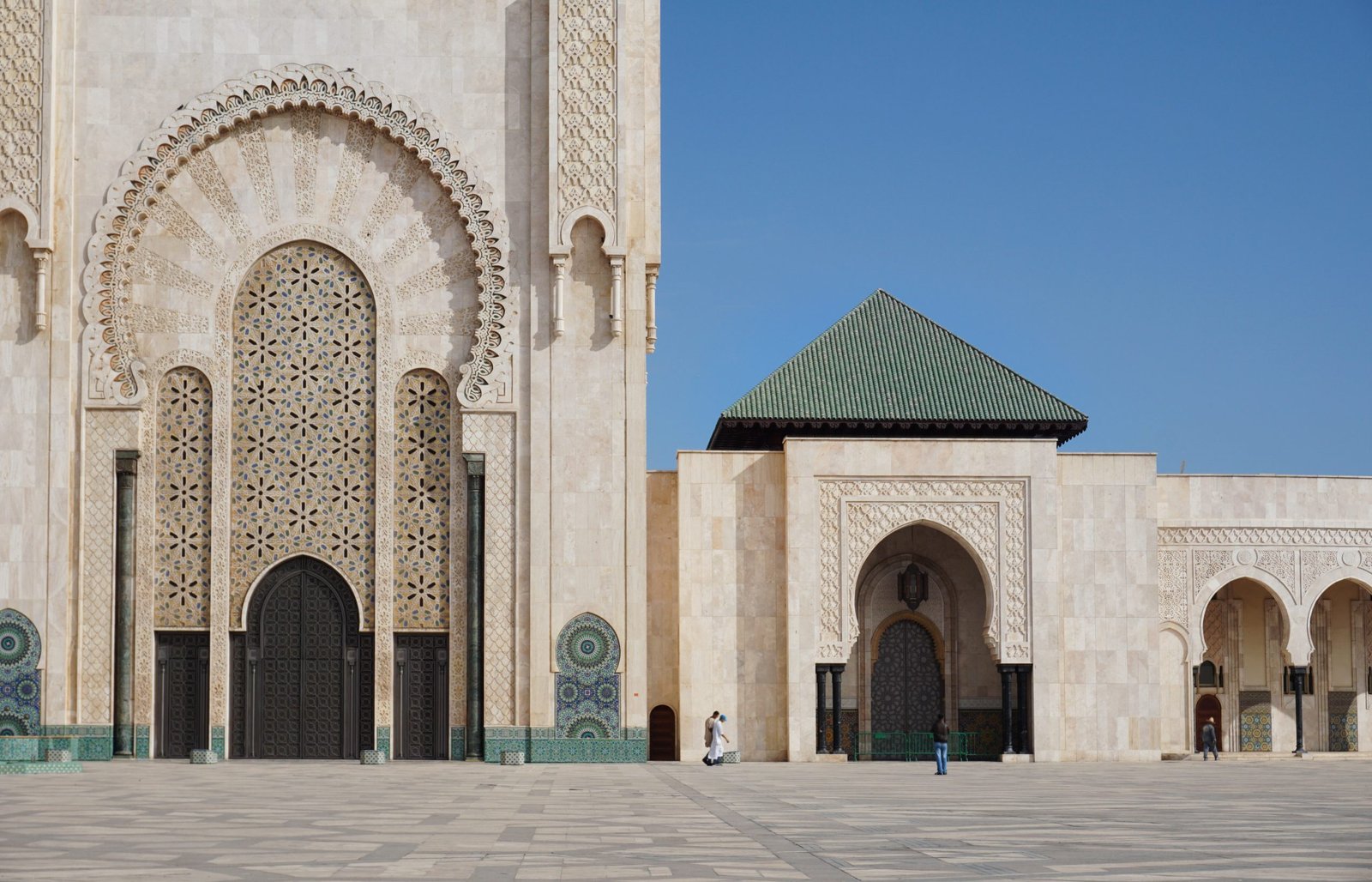Moroccan Mosques: Art of Mosques

Morocco is a predominantly Muslim country with a significant population of followers of Islam. Mosques are some of the country’s most beautiful and significant buildings, and they play a crucial role in the religious and cultural life of the people. You can find mosques in every city, town, and community in Morocco, with hundreds spreading throughout the country. Each of these mosques is unique and aesthetically captivating, and they are all designed based on the rich Islamic architectural artwork that is part of the country’s heritage.
Most mosques in Morocco have tall minaret towers, an iconic feature of the country’s landscape. The minarets are a visual symbol of the mosque and are designed to be visible from a distance. They also have a practical function, as they are used to call the faithful to prayer five times a day. You will hear the call for prayer, “Athan,” echoing from the minarets, inviting Muslims to gather and pray in the mosque. The mosques in Morocco are not only places of worship but also serve as community centers where people come together to socialize, learn, and share their experiences.
Many mosques incorporate different types of mosaic decor, “called zellij. Thus, they are wonderfully decorated. The mosque wall and “Mihrab,” a niche facing Mecca, are mostly decorated using the” Zrllij.” It is where the Imam leads the prayers. However, The Mihrab place is mainly decorated in stucco and marble. Moroccan mosques reflect the true expression of Islamic artifacts and design. This, in turn, plays a significant influence on Moroccan architecture.
Moroccan Mosques: Koutoubia Mosque
Koutoubia Mosque is one of the ancient mosques in Morocco. It is the most famous historical site of worship and the largest in the city of Marrakesh. It is located in the city center.
This ancient mosque is well decorated with:
- Ceramic strip
- Curved windows,
- Pointed merlons
- Some of the most ancient stylish arches.
- A large square garden is attached to the mosque, which is beautifully lit at night.
The Koutoubia Mosque is a magnificent Islamic structure that dates back to the 12th century. It was built during the era of Almohad’s age and was commissioned by the Berber Almohad Caliph Yaqub al-Mansour, who reigned from 1184 to 1199. The Almoravids originally built the mosque, but later, the Almohad rulers decided to demolish it and make it again to ensure the mosque was correctly facing the direction of Mecca.
The Koutoubia Mosque is situated in the heart of Marrakech, and throughout history, it has been surrounded by booksellers, which is where its name, Koutoubia, originated. The mosque’s name is derived from the Arabic word “kutubiyyin,” meaning booksellers. This is because the area surrounding the mosque was once a bustling market where books and manuscripts were sold.
The Koutoubia Mosque is an excellent example of Moorish architecture; its design and style are remarkable. The mosque features beautiful keystone arches and decorative stonework characteristic of Moorish architecture. The mosque’s rose-colored walls blend perfectly with the rest of the city’s buildings, giving Marrakech a distinctive style and design. It’s worth noting that all buildings in Marrakech are colored similarly to the Koutoubia mosque, which makes the city a visual treat for visitors.
Here are some quick facts about Kautobia Mosque
- The minaret is two hundred and fifty-two feet high.
- The tower has a pink rock wall decorated with floral motifs and four copper.
- It has identical and well-designed naves, a substantial central, and sixteen parallel.
- It is a symbol of Marrakesh as It reflects the ultimate building of its kind.
- Inside it are one-hundred and twelve columns in 58,000 square feet.
- The tower used to be decorated with blue, blue-green, and white shades at the top. This was before the current design and color.
Moroccan Mosques: Hassan II Mosque
- Hassan II Mosque in Morocco is one of the biggest in the world. It is a massive and the most beautiful mosque worldwide.
- In 1986, it was started to be built. Its construction was finished on August 30th, 1993. This date represents the eve of the prophet Muhammad’s birthday celebration.
- Six thousand prominent artisans participated in building this mosque. The artisans and workers worked tirelessly around the clock non-stop.
- The artisans designing and working this mosque were carefully picked. This was based on their excellent artwork skills.
- The artisans follow the most delicate details and use the finest materials. This ensures the mosque reflects the best one built in Morocco and worldwide.
- It is one of the world’s most prominent, tallest, and most unique buildings in Morocco. Its minaret is 210 metres.
- The mosque reflects one of the most attractive designs in the world. It is one of the iconic places you would want to visit.
- Non-Muslims are welcome to visit the mosque with a team excursion. Thus, it is strongly advised to wear a respectful outfit to get into its amenities and the prayer hall.
To give the mosque a striking and stunning architectural phenomenon, some of the finest materials are used to build it.
These include:
- Marble from Agadir city
- Cedar timber from the Middle Atlas Mountains.
- Exquisitely carved wood.
- Luxurious zellij tiles and Elegant plasterwork.
- Smooth walls that are full of artistic work
Moroccan Mosques: Tin Mall Mosque
Some quick facts about this mosque:
- Tin Mall is a quaint and picturesque village in the heart of the High Atlas mountain range. It is located approximately 100 kilometers away from the historic city of Marrakesh, a renowned destination known for its rich cultural heritage and splendid ancient architecture. The village of Tin Mall is designed in a way that seamlessly blends with its fascinating history, offering visitors a unique opportunity to explore the region’s past while enjoying its natural beauty. From its charming stone houses to the winding cobblestone streets, Tin Mall provides an authentic and immersive experience that enchants and captivates all who visit.
- Centuries ago, in the 1100s, a historic city was developed by Ibn Tumart of the Almohads. This city, still standing today, has a rich history dating back to the Muslim era. In particular, the influence of Muslims from the East and Andalusian can be seen in the overall design of the mosque, which is one of the most prominent landmarks in the city. The mosque’s intricate details and stunning architecture are a testament to the skill and creativity of the people who built it, and it continues to be a source of inspiration and wonder for visitors worldwide.
- According to historical records, the Tin Mall mosque was built in 1156 to honor the famous religious figure Ibn Tumart. It served as a center of worship and a gathering place for the faithful for over a century. However, in 1270, the town surrounding the mosque was destroyed by unknown forces, leaving nothing but ruins. Despite the devastation, the Tin Mall mosque remained standing, a testament to the resilience and perseverance of the people who built it. Today, the mosque is considered a cultural and historical landmark, attracting visitors from all over the world who come to marvel at its intricate architecture and rich history.
- Historically speaking, the place in question had once served as the cultural and spiritual hub of the Almohad empire. This North African Berber Muslim dynasty ruled a vast region from the Iberian Peninsula to modern-day Tunisia and Libya. However, the Almohads were eventually ousted from power by the Merinid dynasty, which went on to become the new ruling power in the region. Despite the change in rulers, the location continued to hold significant cultural and spiritual importance for the region’s people.
- This historical site went through a complete renovation and restoration process, which was completed in 1990. As a result of the restoration, the site has been preserved in its original state and is now open to visitors who do not practice the Muslim faith. This means that people who belong to other religions or don’t follow religious beliefs can explore and learn about this fascinating site.
- The mihrab plays a crucial role in the mosque as it is a focal point for worshippers and the Imam, who leads the prayers. The mihrab’s intricate design and intricate detailing will surely leave you mesmerized.
- It symbolizes the spiritual and religious significance attached to the mosque and is a sight to behold. If you plan on visiting this mosque, I highly recommend taking some time to appreciate the beauty of the mihrab and what it represents. It is an excellent opportunity to gain insight into the Islamic faith and its practices.
- There is a minaret Above the mihrab, which is out of the norm. This is because the tower is always built separately from where the mihrab is. This gives the mosque a distinct touch, as this is very unusual.
- The designers of this mosque incorporate many decorative elements and very appealing artworks. It is vaulted pillars, molded or carved stucco, and almost all geometric motifs.




